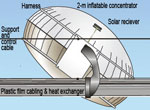|
|
A fleet of kites could harvest enough energy from high-altitude winds to power New York, report researchers from the Carnegie Institution and California State University.
Using 28 years of data from the National Center for Environmental Prediction and the Department of Energy, Ken Caldeira of the Carnegie Institution’s Department of Global Ecology and Cristina Archer of California State University, Chico compiled the first global survey of wind energy available at high altitudes in the atmosphere. They found that the regions best suited for harvesting this energy align with population centers in the eastern U.S. and East Asia, although they note that “fluctuating wind strength still presents a challenge for exploiting this energy source on a large scale.”

|
“There is a huge amount of energy available in high altitude winds,” said coauthor Ken Caldeira. “These winds blow much more strongly and steadily than near-surface winds, but you need to go get up miles to get a big advantage. Ideally, you would like to be up near the jet streams, around 30,000 feet.”
“We found the highest wind power densities over Japan and eastern China, the eastern coast of the United States, southern Australia, and north-eastern Africa,” said lead author Archer. “The median values in these areas are greater than 10 kilowatts per square meter. This is unthinkable near the ground, where even the best locations have usually less than one kilowatt per square meter.”
“For cities that are affected by polar jet streams such as Tokyo, Seoul, and New York, the high-altitude resource is phenomenal,” Archer continued. “New York, which has the highest average high-altitude wind power density of any U.S. city, has an average wind power density of up to 16 kilowatts per square meter.”
Several technologies have been proposed to harvest these high altitude winds, including tethered, kite-like turbines that would be floated to the altitude of the jet streams at an altitude of 20,000-50,000 feet and transmit up to 40 megawatts of electricity to the ground via the tether.
But don’t expect the high altitude wind harvesting to begin right away. Th researchers say that a lot needs to fall into place before the technology is feasible for large-scale electricity generation.
“While there is enough power in these high altitude winds to power all of modern civilization, at any specific location there are still times when the winds do not blow,” said Caldeira. Even over the best areas, the wind can be expected to fail about five percent of the time. “This means that you either need back-up power, massive amounts of energy storage, or a continental or even global scale electricity grid to assure power availability. So, while high-altitude wind may ultimately prove to be a major energy source, it requires substantial infrastructure.”
Reference: Archer, C. L.; Caldeira, K. Global Assessment of High-Altitude Wind Power. Energies 2009, 2, 307-319.
Balloon technology could cut cost of solar energy 90% by 2010

(02/21/2007) With high energy prices and mounting concerns over human-induced climate change, there is intense interest in renewable energy, especially solar, which produces no pollution and is readily available in the form of sunlight. In recent years, however, the solar energy market has been hampered by supply shortages of refined silicon, the critical resource needed for solar cell fabrication. Further, because solar installations traditionally require a large surface area to capture as much sunlight as possible, solar arrays often take up real estate, occupying land used agricultural production and other purposes. Without government subsidies, solar is not presently viable in many areas.
U.S. can cut oil imports to zero by 2040, use to zero by 2050

(03/29/2007) The United States could dramatically cut oil usage over the next 20-30 years at low to no net cost, said Amory B. Lovins, cofounder and CEO of the Colorado-based Rocky Mountain Institute, speaking at Stanford University Wednesday night for a week-long evening series of lectures sponsored by Mineral Acquisition Partners, Inc.
Nobel prize winner debates future of nuclear power
(06/07/2007) Two renowned energy experts sparred in a debate over nuclear energy Wednesday afternoon at Stanford University. Amory Lovins, Chairman and Chief Scientist of the Rocky Mountain Institute, an energy think tank, argued that energy efficiency and alternative energy sources will send nuclear power the way of the dinosaurs in the near future. Dr. Burton Richter, winner of the 1976 Nobel Prize in physics, said that nuclear would play an important part of the future energy portfolio needed to cut carbon emissions to fight global warming.